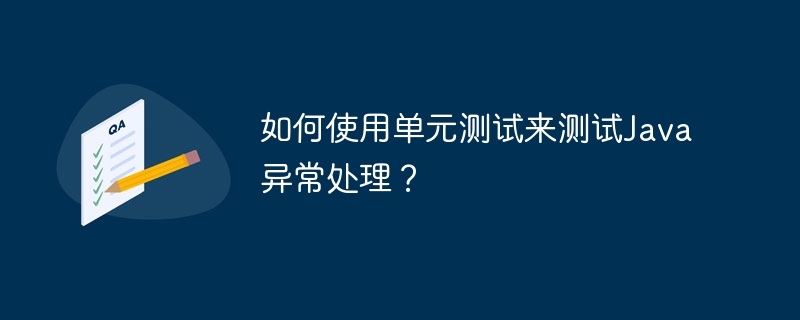Home >Java >javaTutorial >How to use unit tests to test Java exception handling?
How to use unit tests to test Java exception handling?
- WBOYWBOYWBOYWBOYWBOYWBOYWBOYWBOYWBOYWBOYWBOYWBOYWBOriginal
- 2024-04-12 10:36:02711browse
When testing exception handling in Java, you can use several methods: assert that an exception is thrown (using assertThrows()), expect an exception (use expected()), and verify the exception message (use assertThat()). Through these methods, exception handling can be fully tested to ensure the correctness and reliability of the code. For example, to test the exception that is thrown when the username is null, you can use the assertThrows() method to verify that it behaves as expected.

How to use unit testing to test Java exception handling
Unit testing is crucial to ensure the correctness and reliability of the code , which includes testing for exception handling. In Java, you can use a variety of methods to test exception handling, including:
1. Assert that an exception is thrown
You can useassertThrows()Method to assert that a method will throw a specific exception when called:
import static org.junit.jupiter.api.Assertions.*;
class UserService {
public void deleteUser(String username) {
if (username == null) {
throw new IllegalArgumentException("Username cannot be null");
}
}
}
public class UserServiceTest {
@Test
public void deleteUser_whenUsernameIsNull_throwsIllegalArgumentException() {
UserService userService = new UserService();
assertThrows(IllegalArgumentException.class, () -> userService.deleteUser(null));
}
}2. Expected exception
You can also use expected() Annotation to customize the exception message:
import org.junit.jupiter.api.Test;
class UserService {
public void deleteUser(String username) {
if (username == null) {
throw new IllegalArgumentException("Username cannot be null");
}
}
}
public class UserServiceTest {
@Test(expected = IllegalArgumentException.class)
public void deleteUser_whenUsernameIsNull_throwsIllegalArgumentException() {
UserService userService = new UserService();
userService.deleteUser(null);
}
}3. Verify exception message
To verify that the thrown exception has a specific message, you can use assertThat()Method:
import org.hamcrest.CoreMatchers;
import static org.hamcrest.MatcherAssert.*;
import static org.hamcrest.Matchers.*;
import org.junit.jupiter.api.Test;
class UserService {
public void deleteUser(String username) {
if (username == null) {
throw new IllegalArgumentException("Username cannot be null");
}
}
}
public class UserServiceTest {
@Test
public void deleteUser_whenUsernameIsNull_throwsIllegalArgumentExceptionWithMessage() {
UserService userService = new UserService();
try {
userService.deleteUser(null);
fail("Expected an IllegalArgumentException to be thrown");
} catch (IllegalArgumentException e) {
assertThat(e.getMessage(), is("Username cannot be null"));
}
}
}Practice Example
For example, consider a UserService class that has a method deleteUser () to delete the user. To test the exception that is thrown when the user name is null, we can use the assert thrown exception method:
import static org.junit.jupiter.api.Assertions.*;
class UserServiceTest {
@Test
public void deleteUser_whenUsernameIsNull_throwsIllegalArgumentException() {
UserService userService = new UserService();
assertThrows(IllegalArgumentException.class, () -> userService.deleteUser(null));
}
}By using these methods, you can comprehensively test various aspects of exception handling in your Java application aspect to ensure that it behaves as expected.
The above is the detailed content of How to use unit tests to test Java exception handling?. For more information, please follow other related articles on the PHP Chinese website!

